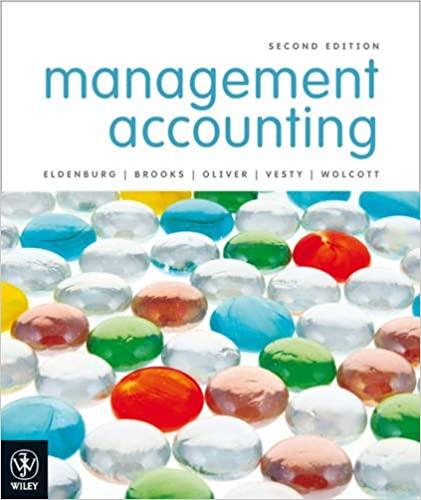Answered step by step
Verified Expert Solution
Question
1 Approved Answer
The company's discount rate is 21%. Click here to view and to determine the appropriate discount factor(s) using tables. Required: 1. Calculate each product's payback




The company's discount rate is 21%. Click here to view and to determine the appropriate discount factor(s) using tables. Required: 1. Calculate each product's payback period. 2. Calculate each product's net present value. 3. Calculate each product's internal rate of return. 4. Calculate each product's profitability index. 5. Calculate each product's simple rate of return. 6 a. For each measure, identify whether Product A or Product B is preferred. 6 b. Based on the simple rate of return, which of the two products should Lou's division accept? Complete this question by entering your answers in the tabs below. Calculate each product's net present value. Note: Round your final answers to the nearest whole dollar amount. The company's discount rate is 21%. Click here to view and to determine the appropriate discount factor(s) using tables Required: 1. Calculate each product's payback period. 2. Calculate each product's net present value. 3. Calculate each product's internal rate of return. 4. Calculate each product's profitability index. 5. Calculate each product's simple rate of return. 6a. For each measure, identify whether Product A or Product B is preferred. 6b. Based on the simple rate of return, which of the two products should Lou's division accept? Complete this question by entering your answers in the tabs below. Calculate each product's internal rate of return. Note: Round your percentage answers to 1 decimal place i.e. 0.123 should be considered as 12.3%. Click here to view and to determine the appropriate discount factor(s) using tables. Required: 1. Calculate each product's payback period. 2. Calculate each product's net present value. 3. Calculate each product's internal rate of return. 4. Calculate each product's profitability index. 5. Calculate each product's simple rate of return. 6a. For each measure, identify whether Product A or Product B is preferred. 6b. Based on the simple rate of return, which of the two products should Lou's division accept? Complete this question by entering your answers in the tabs below. Calculate each product's profitability index. Note: Round your answers to 2 decimal places. Click here to view and to determine the appropriate discount factor(s) using tables. Required: 1. Calculate each product's payback period. 2. Calculate each product's net present value. 3. Calculate each product's internal rate of return. 4. Calculate each product's profitability index. 5. Calculate each product's simple rate of return. 6 a. For each measure, identify whether Product A or Product B is preferred. 6b. Based on the simple rate of return, which of the two products should Lou's division accept? Complete this question by entering your answers in the tabs below. Calculate each product's simple rate of return. Note: Round your percentage answers to 1 decimal place i.e. 0.123 should be considered as 12.3%. The company's discount rate is 21%. Click here to view and to determine the appropriate discount factor(s) using tables. Required: 1. Calculate each product's payback period. 2. Calculate each product's net present value. 3. Calculate each product's internal rate of return. 4. Calculate each product's profitability index. 5. Calculate each product's simple rate of return. 6 a. For each measure, identify whether Product A or Product B is preferred. 6 b. Based on the simple rate of return, which of the two products should Lou's division accept? Complete this question by entering your answers in the tabs below. Calculate each product's net present value. Note: Round your final answers to the nearest whole dollar amount. The company's discount rate is 21%. Click here to view and to determine the appropriate discount factor(s) using tables Required: 1. Calculate each product's payback period. 2. Calculate each product's net present value. 3. Calculate each product's internal rate of return. 4. Calculate each product's profitability index. 5. Calculate each product's simple rate of return. 6a. For each measure, identify whether Product A or Product B is preferred. 6b. Based on the simple rate of return, which of the two products should Lou's division accept? Complete this question by entering your answers in the tabs below. Calculate each product's internal rate of return. Note: Round your percentage answers to 1 decimal place i.e. 0.123 should be considered as 12.3%. Click here to view and to determine the appropriate discount factor(s) using tables. Required: 1. Calculate each product's payback period. 2. Calculate each product's net present value. 3. Calculate each product's internal rate of return. 4. Calculate each product's profitability index. 5. Calculate each product's simple rate of return. 6a. For each measure, identify whether Product A or Product B is preferred. 6b. Based on the simple rate of return, which of the two products should Lou's division accept? Complete this question by entering your answers in the tabs below. Calculate each product's profitability index. Note: Round your answers to 2 decimal places. Click here to view and to determine the appropriate discount factor(s) using tables. Required: 1. Calculate each product's payback period. 2. Calculate each product's net present value. 3. Calculate each product's internal rate of return. 4. Calculate each product's profitability index. 5. Calculate each product's simple rate of return. 6 a. For each measure, identify whether Product A or Product B is preferred. 6b. Based on the simple rate of return, which of the two products should Lou's division accept? Complete this question by entering your answers in the tabs below. Calculate each product's simple rate of return. Note: Round your percentage answers to 1 decimal place i.e. 0.123 should be considered as 12.3%
Step by Step Solution
There are 3 Steps involved in it
Step: 1

Get Instant Access to Expert-Tailored Solutions
See step-by-step solutions with expert insights and AI powered tools for academic success
Step: 2

Step: 3

Ace Your Homework with AI
Get the answers you need in no time with our AI-driven, step-by-step assistance
Get Started


